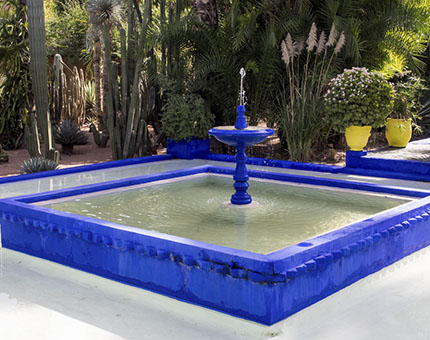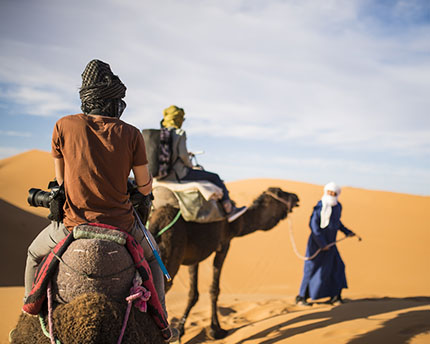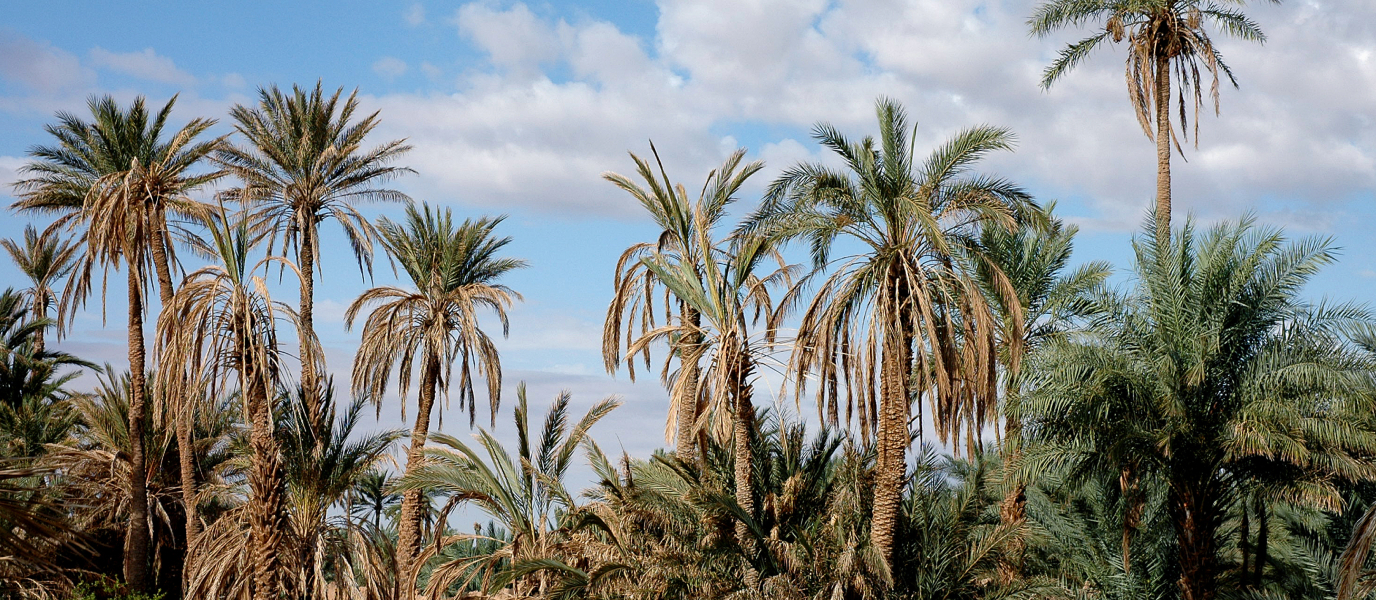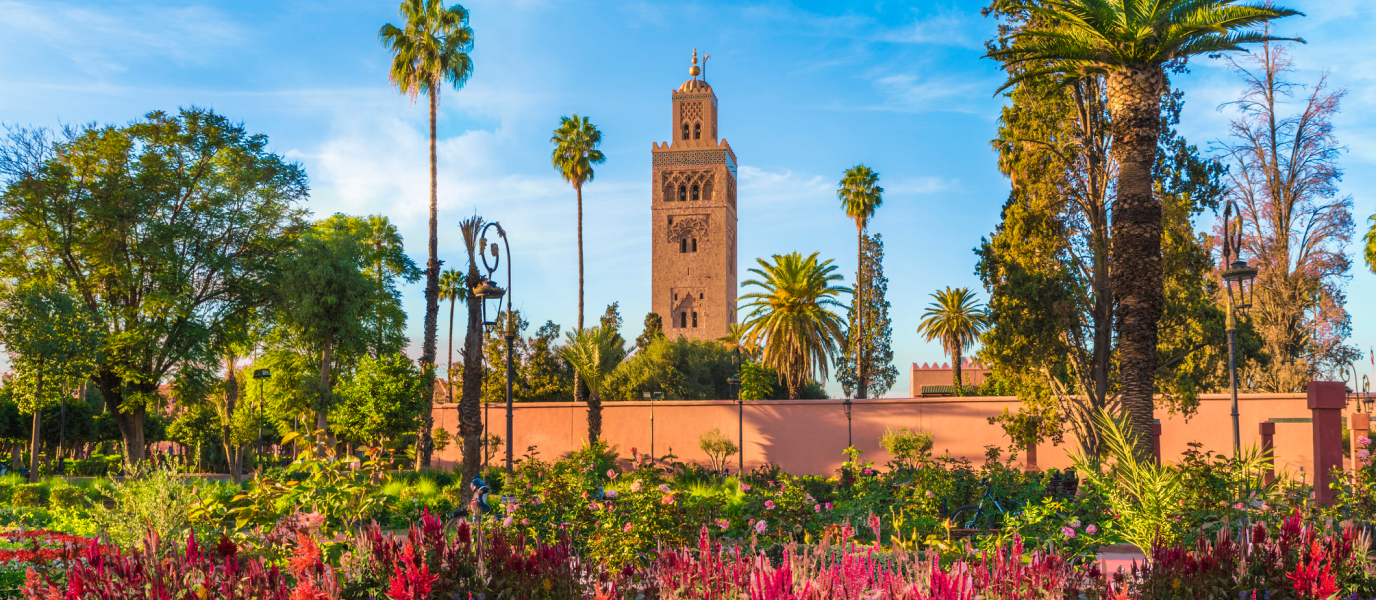Far removed from the hustle and bustle of the city, the souks, the narrow streets and other exotic corners of Marrakesh, the Majorelle Garden presents a surprising and refreshing scene. This spot in Guéliz, the city’s European neighbourhood very near the bustling Jemaa el Fna Square, is surprisingly quiet and refined. Travellers from all over the world visit this garden, attracted by its beauty and its history.
With its abundant palm trees and fountains, this garden was born of the imagination of the French painter Jacques Majorelle. In 1924, the artist designed this horticultural work of art. It took him years to bring to fruition his idea of an oasis of serenity and harmony to complement a building in a deep indigo colour with a blend of Moorish and art deco styles. In 1980, when the site had fallen into neglect, the designer Yves Saint Laurent fell in love with it and acquired it.
History del Majorelle Garden. An artist’s dream
The history of the Majorelle Garden goes back to 1917. That was the year when the French painter Jacques Majorelle arrived in Marrakesh. He fell in love with the city at first sight, seduced by its colour and energy. Here he found a source of inspiration, a place that suited his creative imagination. Years later, he bought a plot of land surrounded by palm trees. Step by step, he converted it into his house, his studio and his personal paradise.
The Moorish-Spanish style of the main building, the Bou Saf Saf villa, was embellished with bold art deco touches in the area he used as his studio. In 1937, the building was painted a vibrant cobalt blue, in contrast with the other colours there, such as the yellow and orange of walls, pergolas, fountains, and other decorative features. This intense colour scheme gives visitors the feeling of being inside a painting. In the garden, the shaded paths, streams and ponds, water lilies and lotus flowers transport the visitor to another reality.
In the same way that Monet painted the famous Giverny garden (immortalised in his paintings of water lilies), Majorelle exercised his skills on this space that bears his name and which embodies the spirit of his artistry. As you walk around the garden, you will see Mediterranean plant species mingling with those from the sub tropics. Palm trees, hibiscus, jasmine, fig trees, cypress, oleanders, orange and banana trees, bougainvillea, coconut palms, agave, yucca, bamboo, and cactus all contribute to the garden’s exuberance and its seductive quality.
The garden was opened to the public in 1946. Its creator took the decision to allow visits by the public in order to alleviate the premises’ high maintenance costs. The fashion designer Yves Saint Laurent and his partner, the businessman and patron Pierre Bergé (both great admirers of Morocco), visited here in the late 1960s, and felt a strong attraction to the place.
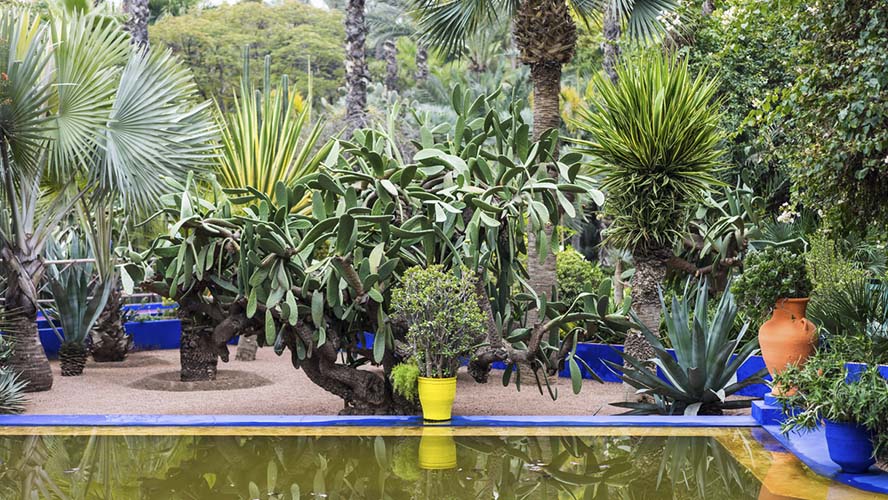
Yves Saint Laurent and his Villa Oasis
The first time Yves Saint Laurent set eyes on the Majorelle Garden, he felt that, somehow, there was a connection between its elegance and colour and his work in the world of fashion. A passion for Eastern culture is present in every aspect of Saint Laurent’s life and work. His love affair with Majorelle’s creation was long lived. He himself said that what he discovered there served to heighten the boldness of his designs and his own use of colour.
In 1980, as the house was falling into disrepair and the garden neglected, Saint Laurent decided to buy the property, in partnership with his partner Pierre Bergé. Thus, they were able to prevent the place being converted into a hotel, and they kept alive the legacy of Jacques Majorelle. A refurbishment was undertaken. The designer Bill Willis was brought in, and new species of plants were added to the garden; from the 135 original species, the total was increased to over 300.
The Bou Saf Saf Villa became Villa Oasis, the residence of Saint Laurent and Pierre Bergé in Marrakesh. Many of Saint Laurent’s fashion collections were inspired by Morocco. The garden remained open to the public, and Majorelle’s former studio was converted into a museum displaying an interesting collection of Berber art.
After his death in 2008, Yves Saint Laurent’s ashes were scattered at Villa Oasis. A small, modest memorial with a Roman column was erected in the garden. As a gesture of gratitude for his love of the city, the street where the garden is located was renamed Rue Yves Saint Laurent. Currently, the Majorelle Garden is under the control of the Pierre Bergé-Yves Saint Laurent Foundation. A team of around 20 gardeners look after this beautiful attraction, which is visited by approximately 700,000 tourists every year.
What to see in the Menara Garden, a space in which to linger
What is a garden for, if not to pause time and relax? A feeling of tranquility sweeps over visitors in this magical corner of Marrakesh, in the area of the former French protectorate. Jacques Majorelle’s love of art and plants can still be appreciated as you walk along the central aisle and the twisting paths that spread out around the garden. On a visit outside the peak tourist hours, the garden’s affecting silence is broken only by the singing of the birds — in marked contrast to the constant hubbub of the area around the Medina.
The greenery of the Majorelle Garden contrasts with the intensity of the primary colours and, especially, with the blue that dominates the architecture. As you walk around, you will come across ponds, streams and fountains that complement the planting scheme. In the southern part of the garden, you will find an impressive collection of palm trees. In addition to native species, there are also specimens from different parts of Africa, the South Pacific, the Mediterranean basin, and the Canary Islands.
Around 60 further varieties of cactus, trees and exotic plants make up this living work of art. The aquatic plants, such as the water lilies and Asian lotus flowers, mark a contrast with the desert that surrounds the city of Marrakesh. Another highlight is the small bamboo grove which stretches across the garden from south to west.
Visit to the Berber Museum
The Majorelle Garden has a snack bar, and a large part of Jacques Majorelle’s former studio is now home to a Berber Museum, open to the public. The museum is divided into three rooms devoted to the native inhabitants of Morocco. A tour of the museum demonstrates the extraordinary creativity of this people, North Africa’s oldest ethnic group.
The museum contains almost 600 exhibits, collected by Pierre Bergé and Yves Saint Laurent from different regions, from the Rif to the Sahara. In the mirror room, there is an impressive collection of chiselled, enamelled, and filigree jewellery.
The Yves Saint Laurent Museum, very close to the garden
The Majorelle Garden, the Berber Museum and, since 2017, the Yves Saint Laurent Museum make up a tour dedicated to the famed fashion designer. The centre dedicated to his designs is in the street that bears his name, a stone’s throw from the Majorelle Garden. This 4,000 m2 building houses thousands of haute couture garments and accessories. They were selected by Pierre Bergé, Saint Laurent’s partner, who died in the year that the museum opened. Iconic pieces by the designer await the visitor in this building shaped by modern and traditional Moroccan influences. The museum has a bookshop, a research library, an auditorium and a snack bar.
























































